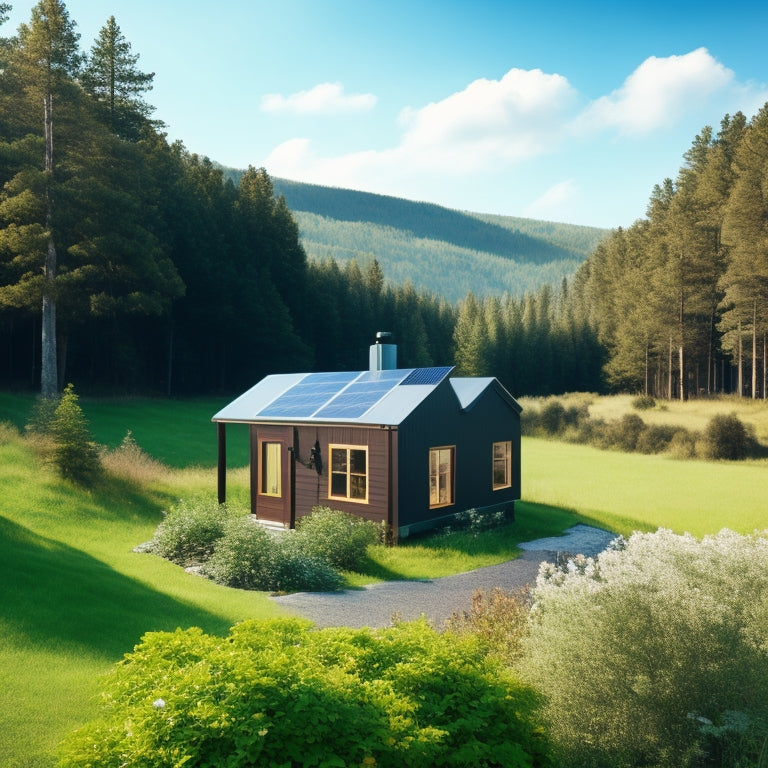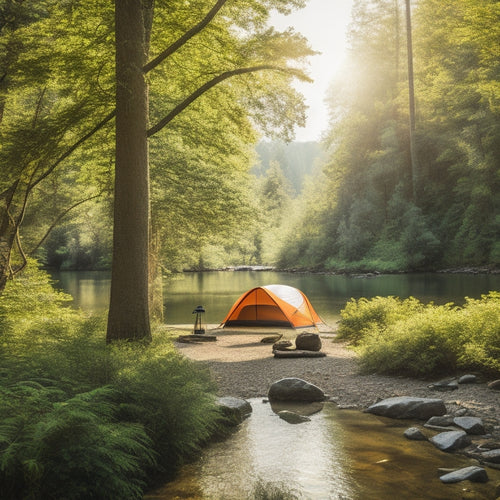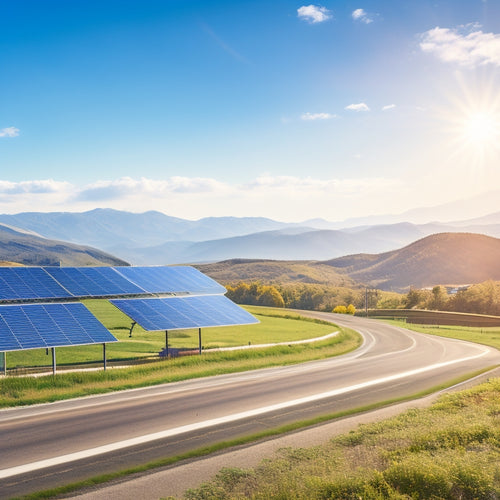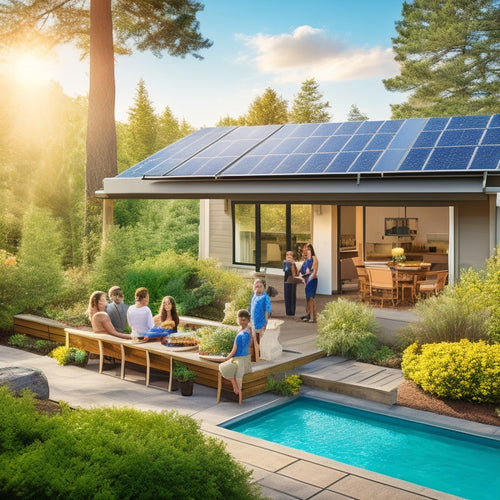
Solar Power for Small Cabin
Share
You can opt for a solar power system that generates enough electricity to completely offset your small cabin's energy consumption, allowing you to achieve zero energy bills and utility costs. This renewable energy source simplifies the design and installation process, minimizing your carbon footprint and environmental impact. To guarantee energy self-sufficiency, it's vital to assess your daily energy demands, considering appliances' wattage and usage hours, and prioritize energy-efficient options. By incorporating maximum power point tracking technology, you can optimize energy collection and maximize power production. Now, you're one step closer to utilizing the full potential of solar power for your small cabin.
The Essentials
- A well-designed solar power system can fully offset cabin energy consumption, eliminating energy bills and utility costs.
- Off-grid solar power systems provide consistent renewable energy flow, guaranteeing autonomous electricity generation without utilities.
- Energy self-sufficiency is achieved through solar power systems, supported by battery backup systems for a steady power supply during low sunlight.
- Determining daily energy requirements is essential for proper system sizing, considering energy-using appliances and energy-efficient options.
- Solar power systems require low maintenance, with simple components and a straightforward setup ideal for remote locations.
Zero Energy Bills
You'll achieve zero energy bills by utilizing a renewable energy source like solar power, which can fully offset your cabin's energy consumption.
With a well-designed solar array, you'll generate enough electricity to power your appliances, lighting, and heating/cooling systems, eliminating your utility costs.
By going solar, you'll fundamentally pay nothing for energy, enjoying significant savings and a reduced carbon footprint.
Additionally, with off-grid solar panel kits, you can overcome the challenges of traditional solar panel systems, ensuring a consistent energy supply and avoiding frequent power outages Off Grid Solar Solutions.
Renewable Energy Source
By incorporating solar power into your small cabin's design, you can tap into a renewable energy source that greatly reduces your reliance on the grid, potentially leading to zero energy bills.
This clean energy source not only benefits your wallet but also the environment. With the help of thorough off-grid solar power systems, you can overcome the complexity and uncertainty of designing and installing a reliable solar system that meets your unique energy needs.
Solar power is a sustainable practice that reduces your carbon footprint, minimizing the impact on the environment. As a renewable energy source, solar power is a reliable and consistent way to generate electricity, reducing your dependence on non-renewable energy sources.
Zero Utility Costs
Achieving zero utility costs is a significant advantage of incorporating solar power into your small cabin's design, as it enables you to break free from the grid and eliminate energy bills altogether.
By installing a solar panel system that matches your cabin's energy requirements, you can utilize the sun's energy to power your appliances, lights, and heating systems. High-efficiency solar panels can maximize energy production, even on cloudy days, guaranteeing you have a reliable source of power.
With an off-grid solar kit, you can enjoy the freedom and independence that comes with generating your own clean energy, while also reducing your environmental footprint.
To secure a zero-utility-cost setup, you'll need to take into account cabin energy storage solutions, such as deep-cycle batteries or Tesla Powerwall systems. These solutions store excess energy generated by your solar panels during the day for use at night or on days with limited sunlight.
By sizing your energy storage system correctly, you can guarantee a seamless shift between daylight and nighttime energy usage, eliminating reliance on the grid and utility bills.
With a well-designed solar power system, you can enjoy the freedom and independence that comes with generating your own clean energy.
Renewable Energy Independence Guaranteed
You've achieved energy self-sufficiency with your small cabin's solar power system, guaranteeing renewable energy independence.
This off-grid power solution enables you to generate electricity autonomously, free from reliance on utility companies, using a reliable off-grid system that combines solar panels, a battery backup, and an inverter.
Energy Self-Sufficiency Achieved
Your solar power system is now generating enough electricity to meet your small cabin's energy demands, making you the proud owner of a self-sufficient retreat.
You've achieved true energy independence, relying solely on the sun's power to fuel your daily needs. This means you're no longer tied to the grid, free from the constraints of traditional energy providers.
Your energy storage system, comprising deep-cycle batteries and a charge controller, guarantees a steady supply of power even during periods of low sunlight.
This sustainable living setup allows you to live off the land, without compromising on comfort or convenience. With your solar power system, you can power your lights, refrigeration, and communication devices, enjoying the peace of mind that comes with being self-sufficient.
As you monitor your system's performance, you'll notice the satisfaction of watching your energy needs being met without relying on external sources.
You've taken a significant step towards a more autonomous lifestyle, one that's both environmentally friendly and cost-effective.
Your small cabin has changed into a symbol of independence, a proof of the power of renewable energy.
Off-Grid Power Solution
As your small cabin relies solely on the sun's power, the off-grid power solution guarantees a consistent flow of renewable energy, ensuring independence from traditional power sources.
This setup enables you to utilize the sun's energy using various solar panel types, such as monocrystalline, polycrystalline, or thin-film panels, depending on your specific needs and budget.
To secure a steady supply of power, you'll need a reliable battery storage system.
This involves selecting the right battery type, such as deep cycle batteries or lithium-ion batteries, and configuring them to meet your energy demands.
A well-designed battery storage system will store excess energy generated during the day for use during the night or on cloudy days.
With an off-grid power solution, you're in control of your energy needs.
You can monitor your energy production and consumption in real-time, making adjustments as needed to optimize your system's performance.
This level of autonomy allows you to live life on your own terms, free from the constraints of traditional power grids.
Maximum Power Point Tracking
You'll want to guarantee your solar power system is equipped with a maximum power point tracking (MPPT) feature to optimize energy harvesting.
For off-grid cabins, it's vital to evaluate renewable energy systems that can provide reliable power, and MPPT technology plays a key role in achieving this.
MPPT technology continuously monitors the solar panel's voltage and current output, adjusting the system's operating point to maximize power production.
Efficient Energy Harvesting
Within a solar power system, efficient energy harvesting relies on maximum power point tracking (MPPT) to optimize the energy extracted from the solar panels. You want to make certain that your photovoltaic system is operating at its highest energy efficiency, and MPPT makes this possible. This technology tracks the maximum power point of the solar panels and adjusts the energy conversion process to match it, resulting in maximum energy output.
When you're off-grid, energy efficiency is essential. MPPT helps you get the most out of your solar panels, which means you can power your small cabin with confidence. Additionally, MPPT enables you to store excess energy in your battery storage system, providing a reliable backup during periods of low sunlight.
With grid-tied systems, MPPT also helps you maximize your solar incentives by feeding excess energy back into the grid. By choosing a high-quality MPPT system, you'll enjoy lower installation costs and a more durable system that will withstand the environmental impact of years of outdoor use.
Optimized Power Output
The maximum power point of your solar panels varies depending on factors like temperature, irradiance, and panel quality. This means that the power output of your solar panels isn't always constant, and you need a way to optimize it to get the most out of your system.
That's where maximum power point tracking (MPPT) comes in. MPPT is a technique that guarantees your solar panels operate at their maximum power point, regardless of the conditions.
By using MPPT, you can increase your solar panel efficiency by up to 30%. This is especially important for small cabins where energy storage options are limited.
MPPT works by continuously monitoring the voltage and current output of your solar panels and adjusting the load to guarantee maximum power output. This results in more energy being generated and stored, giving you more power when you need it.
When selecting an MPPT charge controller, look for one with high efficiency, high voltage tolerance, and compatibility with your energy storage options.
With MPPT, you'll be able to maximize your solar power output, reducing your reliance on the grid and increasing your energy independence.
Assess Your Energy Demands
You'll need to determine your daily energy requirements to size your solar power system correctly. This involves identifying the energy-using appliances you'll need to power in your cabin, such as lights, refrigerators, and computers.
For instance, if you plan to power a refrigerator, consider a deep cycle batteries solution to guarantee a reliable and efficient energy storage system.
Additionally, you may want to investigate portable solar panel kits to provide a flexible and modular energy generation solution.
Daily Energy Requirements
To determine the size of the solar power system you'll need for your small cabin, calculating your daily energy requirements is an essential step. This calculation will help you understand how much energy you'll need to generate from the sun to power your cabin lifestyle.
You'll need to take into account your energy consumption patterns, including the appliances you plan to use, their wattage, and the number of hours they'll be operated daily. For instance, will you be using energy-efficient LED lights or traditional incandescent bulbs? How many lights will you need, and how many hours will they be on?
You should also think about your electronic devices, such as laptops, smartphones, and televisions. How often will you use them, and for how long?
Additionally, consider your heating and cooling needs, as these can greatly impact your energy consumption. By accurately calculating your daily energy requirements, you'll be able to size your solar power system correctly, ensuring you have a reliable source of energy to power your cabin.
Energy-Using Appliances Needed
Energy-efficient cabin living demands a thorough assessment of your energy demands, starting with the appliances you'll need to power your daily routines.
You'll want to identify the essential devices that'll support your off-grid lifestyle. Begin by making a list of the energy-using appliances you can't live without, such as LED lighting, laptop, and refrigerator.
Prioritize energy-efficient appliances that are specifically designed for off-grid living. Look for solar-compatible devices with low power consumption and high efficiency ratings.
For instance, consider a propane-powered refrigerator with a low wattage compressor or a DC-powered fridge designed for solar systems.
When selecting appliances, calculate their individual energy requirements in watt-hours (Wh) per day. This will help you determine the total daily energy load and size your solar array accordingly.
Be mindful of appliances with high surge currents, like pumps and power tools, which may require additional solar panels or a larger battery bank.
Low Maintenance Energy Source
When you opt for a solar power system, you'll appreciate its easy installation process, which typically involves mounting the panels on your cabin's roof and connecting them to an inverter and battery bank.
This straightforward setup minimizes the need for complex wiring or trenching, making it an ideal choice for remote locations.
Easy Installation Process
Five key components - the solar panel array, charge controller, battery bank, inverter, and mounting hardware - comprise a typical solar power system for a small cabin. You'll be relieved to know that installing these components is relatively straightforward. With some basic DIY skills and the right tools, you can set up your solar power system in no time.
Here's a breakdown of the installation process:
| Component | Installation Tips | DIY Setup |
|---|---|---|
| Solar Panel Array | Guarantee a secure and level mounting | Use a prefabricated mounting kit |
| Charge Controller | Connect to battery bank and solar panel array | Follow manufacturer's wiring diagram |
| Battery Bank | Place in a well-ventilated area, away from flammable materials | Use a deep cycle battery designed for off-grid systems |
| Inverter | Connect to battery bank and electrical panel | Choose an inverter with a built-in transfer switch |
Frequently Asked Questions
Can Solar Power Systems Be Installed in Shaded Areas?
You can install solar power systems in shaded areas, but you'll need to optimize panel placement for maximum efficiency. Shaded areas reduce energy output, so consider adjusting panel angles, cleaning schedules, and using high-efficiency panels to minimize losses.
Are Solar Panels Resistant to Extreme Weather Conditions?
As you venture into the domain of renewable energy, you'll find that solar panels are indeed resilient, boasting impressive weather durability and storm resistance, with many models designed to withstand Category 4 hurricane-force winds and hail.
How Long Do Solar Power Systems Typically Last?
You'll find that a well-maintained solar power system can last around 25-30 years, with individual solar panels warrantied for 25 years or more; regular maintenance checks and cleaning guarantee peak performance and extend the solar panel lifespan.
Can I Expand My Solar Power System in the Future?
You'll be pleased to know that 90% of solar panels still operate at 80% capacity after 25 years. When you're ready, you can expand your system by upgrading individual components or adding new panels, ensuring seamless capacity planning and flexible system upgrades to meet your growing energy needs.
Are There Any Government Incentives for Solar Power Systems?
You're eligible for federal tax credits, covering up to 26% of your solar power system's cost, and might qualify for local rebates, which vary by state and utility company, so research these incentives to maximize your savings.
Final Thoughts
As you flip the switch on your solar-powered cabin, the silence is golden - no humming generators, no hissing fuel lines. You've captured the ferocity of the sun, taming its wild energy to fuel your off-grid oasis. With maximum power point tracking, your system optimizes every photon, ensuring zero energy bills and renewable energy independence. You've broken free from the grid's shackles, embracing a low-maintenance energy source that's as reliable as the sunrise.
Related Posts
-

Top Eco-Friendly Camping Equipment for a Sustainable Adventure
When you're camping with the planet in mind, opt for eco-friendly gear like tents made from recycled materials and bi...
-

Is Switching to Green Energy Solutions Easy
Switching to green energy solutions isn't just easy; it's also beneficial. You can greatly cut utility costs and enjo...
-

Top-Rated Home Solar Power Kits for Achieving Energy Independence
Top-rated home solar power kits enable you to achieve energy independence by greatly cutting your energy costs. You c...


